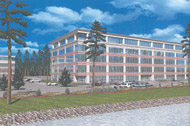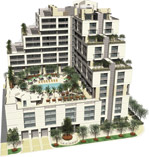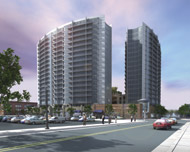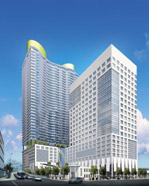|
COVER STORY, SEPTEMBER 2004
THE SOUTHEAST EMBRACES MIXED-USE DEVELOPMENT
Many residents in the Southeast are trading in their long
commutes for a chance to walk to work.
Dawn Pick Benson
 |
|
Yates
|
|
Mixed-use development is beginning to come into its own in
the Southeast, according to Todd Yates, senior vice president
of national development at The Alter Group. Although mixed-use
development has historically been situated in large metropolitan
areas such as New York, Chicago and Boston, it recently has
made its way south to cities like Atlanta and Fort Lauderdale,
Florida.
A Growing Trend
One reason for this trend is the growing population base in
the South. “I think mixed-use is a reaction to the excesses
of urban sprawl and an expanding population base in the South,
which has fragmented our communities and strained our infrastructure,”
says Yates. He says that true mixed-use projects ease the
movement and congregation of people as they travel between
work, school and other activities. They offer ideal live,
work and play environments.
“Atlanta residents have been historically tied to their
cars,” says Yates, “but the city has grown to a
size in which people are commuting an hour to work each day.
Many are now thinking, ‘Why not move into the city and
walk to work, or at least be fairly close to work?’ This
is what I think has driven mixed-use development in Atlanta.”
Fort Lauderdale is another city that is experiencing this
shift toward mixed-use development, says Yates. “In the
past 2 years, there have been at least a half-dozen high-rise
residential projects going up downtown near the CBD office
area.”
Recent economic conditions are also a reason for this growing
interest in mixed-use development. Because of the recent economic
slump and its negative impact on the office market over the
past 3 to 4 years, Yates says many developers have shifted
to residential development in order to utilize land they already
have or serve as a reason to begin new developments. “A
lot of developers who have never done high-rise residential
are now getting into it,” says Yates. “Our company
is a good example. We have several projects now that we’re
considering for mixed-use development.”
Challenges
When it comes to mixed-use development, there are several
hills that must be climbed before a project is finished. For
example, the timing of each phase is often a challenge. “It’s
hard to align the stars so that all product types within a
mixed-use development can come on line concurrently,”
Yates says. “A perfect analogy is the discordance between
the residential and commercial sectors. The residential has
been buoyed by low interest rates and a shortage in the supply
of single-family homes, and the commercial is still feeling
the effects of the recession. The mixed-use formula is further
complicated by the often contradictory objectives of the different
components: residential users may seek out retail amenities
for all of their needs — supermarkets, big box retail,
boutique stores — but don’t want the commensurate
rise in congestion; retail tenants may seek out a solid residential
component but find they don’t have the parking or outside
traffic to meet their sales goals. It is a complex mix that
requires foresight and the right timing to overcome the challenges.”
Financing can also be an issue. “The financing structure
is a lot more complicated,” says Yates. “And because
it is more complicated and you are crossing product-type lines,
the lenders in the financial community that either have the
understanding or desire to go through such a complex transaction
are limited.”
There are also new building codes that must be taken into
consideration in designing each project. “You have to
consider the functionality as well as new building code issues,”
says Yates.
Finally, analyzing the market can often be difficult. “You
have to decide on the level of housing that you want to offer,”
says Yates. “Do you want to build $250,000 homes or $1
million homes?” He says retail is also an important support
amenity for a project, so a developer must be sure to choose
the appropriate types of restaurants or support services.
This will help the sale of the residential as well as the
leasing of office space. “The worst thing you can do
is have vacant first-floor retail,” he says.
Current Projects
 |
|
The Alter Group is lead developer
for the 145-acre office and industrial section
of International Park at World Golf Village in
Jacksonville, Florida.
|
|
International Park at World Golf Village is located immediately
adjacent to the World Golf Village master-planned mixed-use
community on Interstate 95 near Jacksonville, Florida. The
Alter Group is lead developer for the 145.75-acre office and
industrial section. Yates says the company began working on
the development in the summer of 2001, but the events of September
11, 2001, caused the project to be delayed until the market
made a turnaround.
“Activity this year has definitely picked up,” says
Yates. But, he says, the question remains: Is Corporate America
confident enough that the economy is going in the right direction
that companies will start expanding again and creating new
jobs? Yates believes that most companies are waiting until
the presidential election is over and they have several quarters
of solid earnings and growth behind them before they justify
more jobs and a need for more office.
The Alter Group also has developed Brookside Concourse, an
urban/suburban environment located just off Old Milton Parkway
in the Atlanta suburb of Alpharetta. Yates says residential
neighborhoods were already in place, so the company developed
office and retail space and then connected everything through
a series of sidewalks. “We’ve tried to create an
urban environment in the suburbs,” says Yates. The development
also has jogging and running trails, and a daycare facility
and Georgia State University’s North Atlanta campus are
within walking distance. Seven buildings totaling 800,000
square feet have already been completed, and The Alter Group
has one site left to develop. The development will consist
of 72 acres of office development and about 30 acres of retail.
The Road Ahead
Yates believes that mixed-use developments will continue to
be good long-term investments. They have typically done very
well in large, growing cities where there is a defined need,
so he expects them to continue to expand in the Southeast.
For example, when people began moving into the Atlanta area
from cities like New York and Chicago, they were looking for
downtown residential. “It’s what they’re used
to,” says Yates, “and they don’t have the apprehension
that someone who’s always lived in the Atlanta suburbs
might have.” He says this desire creates demand and then
once the product is there, others realize how convenient it
would be to walk to work or to the grocery store.
“Once you create the environment, you not only draw from
people who come from that type of environment, you also expose
it to others,” says Yates. “I think that’s
going to be true, for example, in Fort Lauderdale as well.
There’s never been residential in the downtown area.
But now that there are four or five new 30- to 40-story towers
going up, it’s a natural fit for the transient population
in South Florida.” He says it will also be appealing
to the native who simply never had the opportunity to live
downtown.
Even though there will always be a need for suburban development
for those who want big yards and all the perks that come with
them, Yates believes that mixed-use is a natural fit for empty-nesters
or families without children. “I think people will begin
to re-evaluate that hour-a-day they spend in the car going
to and from work, and many will start looking toward a live,
work and play environment,” says Yates.
| MIAMI ARTS DISTRICT
GAINS MIXED-USE CONDOS
 |
|
PanTerra Developments
is developing City 24
in Miami’s Arts District.
|
|
The Arts District in the Biscayne Corridor of Miami
has proven it is still in high demand with the addition
of City 24, another new mixed-use condominium building.
Located at 24th Street and Biscayne Boulevard, the 15-story
complex will house 119 one- and two-bedroom units ranging
in size from 652 to 1,360 square feet and priced between
$180,000 and $500,000.
City 24 will offer many amenities to its residents. Unit
amenities include 10-foot ceilings in all residences,
floor-to-ceiling sliding glass doors, private balconies
and terraces, walk-in closets and European-style kitchens.
City 24’s 18,000-square-foot retail space on the
ground floor and mezzanine will complement neighborhood
shops. Other on-site amenities include a 15,000-square-foot
pool area and sun deck with heated pool and Jacuzzi; a
third-floor fitness center with locker rooms; shower and
sauna; a yoga studio; a multi-purpose Club Room; a business
center with wireless hi-speed Internet capability; a media
room; and a covered parking garage with security access
controls. Residents will enter the building through a
two-story entrance lobby with 24-hour security and concierge.
City 24 is located in the heart of the Miami Arts District,
just blocks from Miami’s new Performing Arts Center.
Also nearby are world-renowned art collections and galleries,
restaurants and nightclubs, the Design District, American
Airlines Arena, Bayfront Park and Museum Park.
Designed by Revuelta Vega Leon P.A., City 24 is being
developed by PanTerra Developments with completion scheduled
for summer 2006. Unit sales commenced this summer and
are being handled by Carson Realty Group, Inc.
— Allyson Doll
|
| DANIEL, SELIG DEVELOP
IN MIDTOWN ATLANTA
 |
|
Daniel Corporation and
Selig Enterprises are developing
The Plaza Midtown in Atlanta.
|
|
Daniel Corporation and Selig Enterprises are developing
The Plaza Midtown, a 550,000-square-foot, 20-story development
in Atlanta. The project will feature 452 high-rise residential
condominiums in two towers and 70,000 square feet of
retail, dining and entertainment space. The 3.3-acre
site encompasses an entire city block from Eighth Street
to Peachtree Place between Spring and West Peachtree
streets. Construction is scheduled to begin this month,
with first units available first quarter 2006.
The Plaza Midtown will feature reflective glass construction
and offer views of Midtown, Downtown, Buckhead, Stone
Mountain and greater Atlanta. With security and safety
in mind, access from the 881-space parking deck utilizes
a keyless entry system with secured elevator lobbies.
Residential amenities include a large clubroom, fitness
center and deck-top plaza, which will feature a swimming
pool and gathering space. Prices for the one- and two-bedroom
units will begin in the $180s.
Publix will anchor the retail space, occupying 33,600
square feet along Spring Street. The store will offer
its urban “market” concept, featuring gourmet
take-out, an extensive wine selection and fresh sushi
along with traditional grocery items. The remaining retail
space will offer boutique shopping, restaurants and entertainment,
supported by deck parking.
— Julie Fritz Hunt
|
| LATITUDE ADDS TO
BRICKELL VILLAGE
 |
|
Construction on E.A. Fish
Associates’ Latitude on the River in
Miami Beach is scheduled to begin in the
fourth quarter.
|
|
Latitude on the River is a new luxury condominium building
with waterfront property on the Miami River, located
at 615 W. Second Ave. in Miami. The new mixed-use project
is in the midst of Brickell Village, next to fine dining,
upscale hotels and chic nightlife and situated among
landmarks such as The Four Seasons, Mandarin Oriental
and the to-be-developed Mary Brickell Village.
Spanning 2.3 acres, the property will consist of several
components including the 44-story luxury condominium building,
a bistro and riverside café, and Latitude One,
a commercial and retail building. A 35-foot View Promenade
will traverse the entire ground floor of the property,
providing direct views of the river. The property will
offer residents many other features and amenities, including
a two-story lobby, swimming pool, fitness center, billiard
room, business center, home theater, yoga room, Tai Chi
Meditation lawn, sauna and storage.
Latitude on the River will consist of 452 units including
riverfront flats, studios, one-, two- and three-bedroom
tower units and two levels of penthouses. The residences
range in size from 800 to 1,500 square feet while unit
prices range from $180,000 to $600,000. The unit amenities
include Italian-style kitchens, bathrooms with granite
counter tops, wall-to-wall carpeting and tile in the bathrooms
and kitchens.
Arquitectonica designed the condominium project, which
is owned by Boston-based E.A. Fish Associates. Latitude
on the River is being developed by Miami Riverfront Partners.
Construction is set to begin in the fourth quarter of
2004 with completion scheduled for late 2006.
— Allyson Doll
|
©2004 France Publications, Inc. Duplication
or reproduction of this article not permitted without authorization
from France Publications, Inc. For information on reprints
of this article contact Barbara
Sherer at (630) 554-6054.
|
